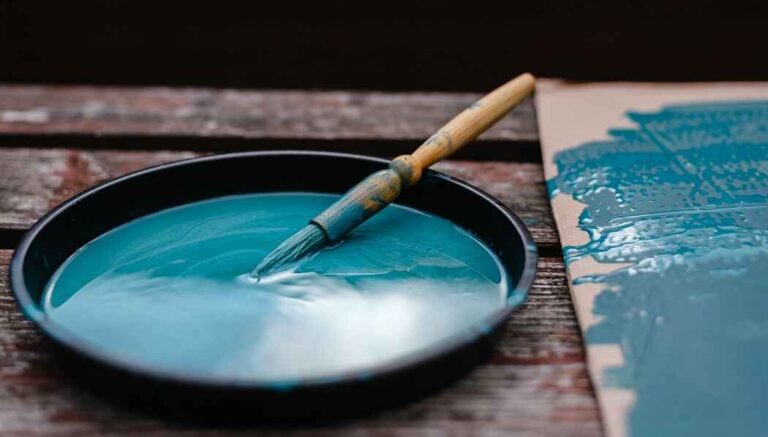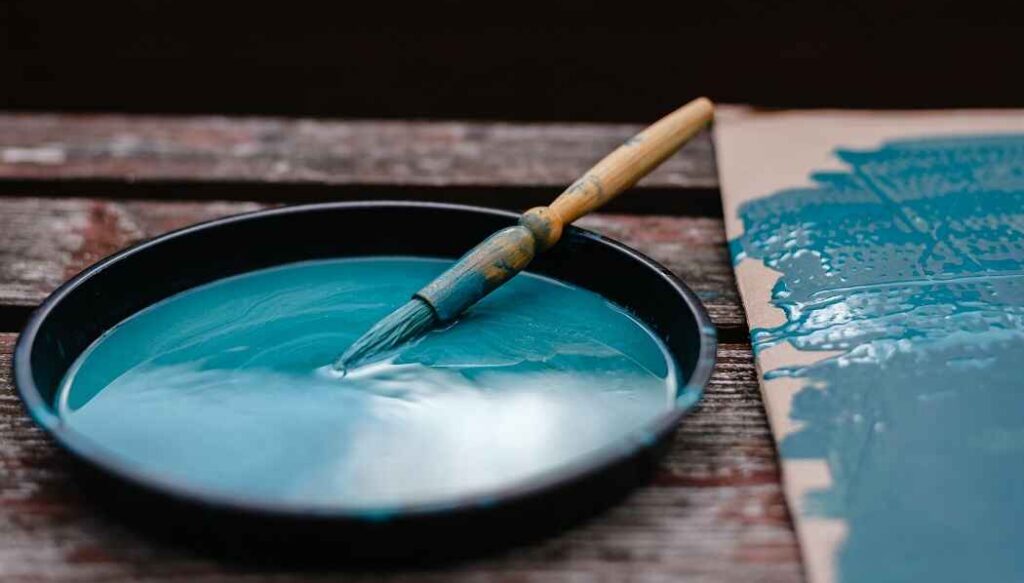
What Happens if You Mix Glue and Paint?
Have you ever found yourself staring at a shelf full of art supplies, wondering about the possibilities that lie within their colorful containers? That moment when you consider combining two seemingly ordinary materials to create something extraordinary, one such intriguing duo that often catches the eye is glue and paint. But what happens if you mix glue and paint?

Let’s uncover the potential reactions, effects, and innovative outcomes of mixing glue and paint!
Can You Mix Glue with Paint?
Of course! Mixing glue with paint is a neat way to make your artwork more interesting. When you mix them, you can create textures that stand out and even make your art look 3D. This is cool because you can feel the textures with your fingers.
Also, when you mix glue and paint, it helps the paint stick better to surfaces like glass or plastic. So, if you want to paint on something tricky, this combo can help your paint stay put.
Remember that cool crackly look some old things have? You can make that with glue and paint! When the mix dries, it shrinks and cracks, revealing the layer underneath. It’s like your artwork has secrets under the surface.
If you’re putting together different things like paper, fabric, or other materials, mixing glue and paint helps them stick together really well. This is super helpful if you’re making a collage.
And guess what? When you mix glue with paint and put it on your art, it can also protect it from things like rain and sun if you want to show it outside.
So, mixing glue and paint isn’t just for fun textures, it’s also a smart way to make your art stick, look cool, and last longer!
Can You Mix Paint with White Glue?
Yes, you can mix paint with white glue, but the results may vary depending on the type of paint and the intended use.
Mixing acrylic paint with white glue can create a textured and opaque consistency suitable for crafts, collages, and some types of artwork. The mixture can be applied to surfaces like paper, cardboard, or canvas.
However, the adhesive properties of the glue might affect the overall durability and flexibility of the paint layer. The resulting mixture may not behave like traditional paint in terms of blending, layering, or smooth application.
For best results, it’s advisable to experiment on a small scale first and test the mixture on the desired surface. Additionally, this mixture is not recommended for projects that require a long-lasting, professional finish, as the glue’s adhesive properties might not provide the same longevity as traditional paint mediums.
Always consider the specific project and purpose before deciding to mix paint with white glue, and be prepared for potential differences in texture, appearance, and performance.
Can You Mix Acrylic Paint and Glue?
Yes, you can mix acrylic paint and glue, and it’s often done for various artistic and craft purposes.
The mixture of acrylic paint and glue can create interesting textures, adhesion properties, and effects. Adding glue to acrylic paint can make the paint thicker and more suitable for techniques like impasto or creating raised textures. This mixture can also be used for collage work, adhering different materials to a surface.
When mixing acrylic paint and glue, it’s important to keep a few things in mind. First, use a clear-drying, acid-free glue to prevent any discoloration or damage over time. Second, the ratio of paint to glue will impact the consistency and transparency of the mixture. Experiment with small amounts to achieve the desired effect. Lastly, be cautious when mixing excessive amounts of glue, as it might affect the paint’s color intensity and drying time.
What Happens if You Mix Glue and Paint?
When you mix glue and paint, the outcome will depend on the specific types of glue and paint you’re using. Let’s explore a few scenarios:
Acrylic Paint and White Glue (PVA):
Acrylic paint is water-based and can be mixed with white glue (also known as PVA – polyvinyl acetate) without causing any significant chemical reactions. The resulting mixture might have a thicker consistency due to the glue, but it will generally retain its color and opacity. This mixture is often used in crafts and art projects to create texture or adhere materials together.
Oil Paint and Glue:
Oil paint is oil-based and doesn’t mix well with water-based substances like glue. Mixing oil paint with glue might result in a separated or curdled appearance, and the paint might not adhere properly to the surface. It’s not recommended to mix these two substances.
Other Types of Paint and Glue:
The compatibility of other types of paint (such as watercolors, tempera, or gouache) with glue depends on their chemical compositions. Watercolors and tempera are water-based like acrylics, so they might mix decently with glue. Gouache, which is similar to watercolor but more opaque, may also work with glue to some extent. However, it’s still important to test the mixture on a small scale before using it in a project.
What Happens if You Put Glue Over Paint?
If you put glue over paint, the outcome will depend on various factors such as the type of glue and paint you’re using, as well as the intended purpose. Here are a few scenarios that could occur:
Adhesion: Depending on the type of glue and paint, the glue might adhere to the paint and create a bond. Some glues are formulated to bond well with painted surfaces, while others might not adhere effectively.
Texture and Appearance: Applying glue over paint could alter the texture and appearance of the painted surface. The glue might dry differently than the paint, leading to a noticeable difference in texture or shine.
Transparency: Some glues dry clear or translucent. If you apply a clear glue over paint, it could potentially create a glossy or shiny finish that might be desirable in certain artistic or craft projects.
Compatibility: Compatibility between the glue and paint is crucial. Some glues might not bond well with certain types of paints, leading to poor adhesion and possible peeling or flaking.
Drying Time: Glue and paint have different drying times. Applying glue over paint could extend the overall drying time, affecting the time it takes for the entire surface to be ready for further handling.
Intended Purpose: The reason for applying glue over paint matters. If you’re using glue to seal and protect the painted surface, you’ll want to ensure that the glue adheres well without causing any undesirable effects. On the other hand, if you’re using glue for artistic effects, it might create interesting textures and patterns.
How to Mix Glue and Paint Safely?
Here’s a step-by-step guide on how to mix glue and paint safely:
Materials You’ll Need:
- Paint: Acrylic paint is commonly used for this purpose, as it’s water-based and easy to work with.
- Glue: White school glue or acrylic gel medium are often used for mixing with paint.
- Mixing Surface: A palette or mixing tray made of non-absorbent material.
- Mixing Tools: Brushes, palette knives, or stir sticks.
- Protective Gear: Disposable gloves, apron, and eye protection (if necessary).
Steps to Follow:
Choose the Right Glue and Paint: Ensure the glue and paint you’re using are compatible. Acrylic paint and white school glue or acrylic gel medium are generally safe to mix. Always read the labels on the products to confirm compatibility and safety information.
Prepare Your Workspace: Work in a well-ventilated area with good air circulation. Cover your work surface with plastic or a disposable drop cloth to protect it from any spills or splatters.
Wear Protective Gear: Put on disposable gloves and an apron to protect your skin and clothing from potential spills or splashes. If you’re concerned about eye contact, wear protective eyewear as well.
Measure the Amounts: Decide on the amount of paint and glue you want to mix. Start with a small amount until you’re familiar with the process.
Mixing: Squeeze the desired amount of paint onto your mixing surface.
- Add a small amount of glue (or acrylic gel medium) to the paint. The ratio can vary depending on the effect you want, but a common starting point is around 1 part glue to 3 parts paint. Adjust as needed.
- Use a brush, palette knife, or stir stick to blend the paint and glue together. Mix thoroughly until you achieve a smooth and consistent mixture. Make sure there are no lumps or streaks.
Test the Mixture: Before applying the mixture to your actual project, it’s a good idea to test it on a separate surface or canvas. This way, you can observe how the paint adheres and dries with the added glue.
Application: Apply the mixed paint and glue mixture to your project using brushes, palette knives, or other appropriate tools. Experiment with different application techniques to achieve the desired texture or effect.
Drying and Cleaning: Allow your project to dry thoroughly according to the drying time recommended for the paint you used. Clean your tools and workspace promptly with water before any residues have a chance to dry.
Disposal: Dispose of any leftover mixture and empty containers according to your local waste disposal regulations.
If you’re unsure about the compatibility of the glue and paint or have concerns about any potential hazards, consider consulting the product labels or seeking advice from experts in the field.
Final Words
The combination of glue and paint can lead to intriguing visual effects in art projects, creating texture and dimension that might not be achievable through separate applications. However, it’s crucial to bear in mind that not all glues and paints are compatible, and certain combinations can result in undesirable outcomes such as cracking, peeling, or a compromised adhesive bond.
